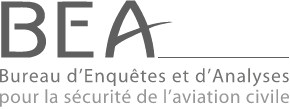Incident to the Airbus A318 - 100 registered F-GUGM operated by Air France on 12/09/2020 at Paris-Orly (Val-de-Marne)
Approche non stabilisée, déclenchement des alarmes MSAW et Glide Slope
Cat. 2 investigation report: simplified-format report, adapted to the circumstances of the occurrence and the investigation stakes.
In descent to Paris-Orly airport, the crew took the opportunity of following a shortened route proposed by the approach controller. The captain (PF) decided to carry out a fast approach, outside the profile specified in the SOP. The radar vectors brought the aeroplane to two dots above the Glideslope, after the gate recommended by the Orly unit (chevron) on the final path. The PF’s strategy was first of all, to maintain 250 kt and to increase the vertical speed to join the approach slope, and then once on the slope, to reduce the speed in order to be able to configure the aeroplane for landing. This led to a temporary deviation from the approach slope.
At 6 NM from the threshold of runway 25, at 2,287 ft (2,000 ft AAL), stabilization was compromised. The crew, who already had a high workload, did not then have the necessary resources to identify that the approach could not be stabilized at 500 ft. At 5.5 NM from the threshold of runway 25, the PF asked for the flaps to be extended to configuration 1. Shortly after, the co-pilot (PM) modified the final configuration for landing, both on the FMS and the overhead panel which probably contributed to his monitoring of the flight parameters becoming less effective. At the same time, having the runway in sight, the PF’s eyes left the instruments. He made a nose-down input which resulted in a high vertical speed which led to the activation of the GPWS warning on board and the MSAW in the tower.
Subsequent to this, continuing the approach was not called into question. The PM had a very high workload, between monitoring the flight path, carrying out the radio communications and continuing the configuration of the aeroplane. At 500 ft AAL, the crew considered that the aeroplane was in the process of stabilizing. They chose to continue as they were convinced that both the stabilization would be quickly acquired after 500 ft and that the landing could be carried out safely.
Without being aware of it, the crew, at this point, probably had very few mental resources available to deal with an unexpected event.
A posteriori, after landing, the absence of consequences in continuing the approach probably reinforced the crew’s belief that their decision had been the right one.
The BEA issues 2 safety recommendations:
- Recommendations FRAN-2021-019 and FRAN-2021-020 / Flight Data Monitoring
The BEA recommends that:
- Whereas one of the principles of FDM is to quantify the operational risks by bringing to light not only the critical occurrences but also the deviations from the SOP;
- Whereas the reliable detection of deviations in operation is essential for designing a suitable training programme;
- Whereas the Air France FDM does not adequately detect non-stabilized approaches nor does it adequately detect the crews’ deviations from the SOP on approach before the stabilization height;
Air France ensure that the automatic detection criteria of non-stabilized approaches, notably before the stabilization height, are close to the reference system described in the Standard Operating Procedures (SOP)
and
The French civil aviation safety directorate (DSAC) ensure that the Air France flight data monitoring system is more relevant in its detection of the crews’ deviation from the Standard Operating Procedures (SOP) on approach.
The recommendations are being processed
The status of the recommendations is available at SRIS2: click here
___________________________________________________________________
Note: in accordance with the provisions of Article 17.3 of Regulation No 996/2010 of the European Parliament and of the Council of 20 October 2010 on the investigation and prevention of accidents and incidents in civil aviation, a safety recommendation in no case creates a presumption of fault or liability in an accident, serious incident or incident. The recipients of safety recommendations report to the issuing authority in charge of safety investigations, on the measures taken or being studied for their implementation, as provided for in Article 18 of the aforementioned regulation.
- Click here to download the "safety digest" as a pdf file.
